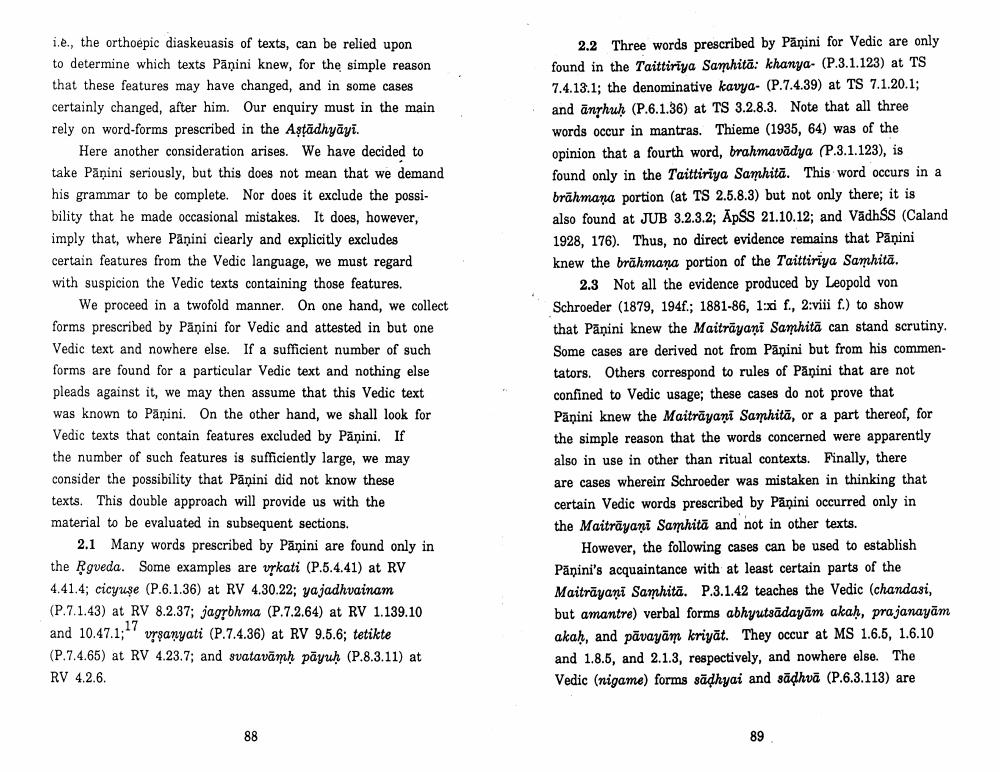Book Title: Paninian And Veda Reconsidered Author(s): Johannes Bronkhorst Publisher: Johannes Bronkhorst View full book textPage 8
________________ i.e., the orthoepic diaskeuasis of texts, can be relied upon to determine which texts Pāṇini knew, for the simple reason that these features may have changed, and in some cases certainly changed, after him. Our enquiry must in the main rely on word-forms prescribed in the Aşțădhyāyi. Here another consideration arises. We have decided to take Panini seriously, but this does not mean that we demand his grammar to be complete. Nor does it exclude the possibility that he made occasional mistakes. It does, however, imply that, where Panini ciearly and explicitly excludes certain features from the Vedic language, we must regard with suspicion the Vedic texts containing those features, We proceed in a twofold manner. On one hand, we collect forms prescribed by Panini for Vedic and attested in but one Vedic text and nowhere else. If a sufficient number of such forms are found for a particular Vedic text and nothing else pleads against it, we may then assume that this Vedic text was known to Panini. On the other hand, we shall look for Vedic texts that contain features excluded by Panini. If the number of such features is sufficiently large, we may consider the possibility that Pāṇini did not know these texts. This double approach will provide us with the material to be evaluated in subsequent sections. 2.1 Many words prescribed by Panini are found only in the Rgveda. Some examples are vrkati (P.5.4.41) at RV 4.41.4; cicyuşe (P.6.1.36) at RV 4.30.22; yajadhvainam (P.7.1.43) at RV 8.2.37; jag?bhma (P.7.2.64) at RV 1.139.10 and 10.47.1;"' vrşanyati (P.7.4.36) at RV 9.5.6; tetikte (P.7.4.65) at RV 4.23.7; and svatavāmh payuh (P.8.3.11) at RV 4.2.6. 2.2 Three words prescribed by Panini for Vedic are only found in the Taittiriya Samhita: khanya- (P.3.1.123) at TS 7.4.13.1; the denominative kavya. (P.7.4.39) at TS 7.1.20.1; and anghuh (P.6.1.36) at TS 3.2.8.3. Note that all three words occur in mantras. Thieme (1935, 64) was of the opinion that a fourth word, brahmavadya (P.3.1.123), is found only in the Taittiriya Samhita. This word occurs in a brāhmana portion (at TS 2.5.8.3) but not only there; it is also found at JUB 3.2.3.2; ApSS 21.10.12; and VādhSs (Caland 1928, 176). Thus, no direct evidence remains that Panini knew the brāhmana portion of the Taittiriya Samhita. 2.3 Not all the evidence produced by Leopold von Schroeder (1879, 194f; 1881-86, 1:xi f., 2.viii f.) to show that Panini knew the Maiträyani Samhita can stand scrutiny. Some cases are derived not from Pānini but from his commentators. Others correspond to rules of Panini that are not confined to Vedic usage; these cases do not prove that Panini knew the Maitrāyani Samhitä, or a part thereof, for the simple reason that the words concerned were apparently also in use in other than ritual contexts. Finally, there are cases wherein Schroeder was mistaken in thinking that certain Vedic words prescribed by Panini occurred only in the Maiträyani Samhita and not in other texts. However, the following cases can be used to establish Pāṇini's acquaintance with at least certain parts of the Maitrāyani Samhitā. P.3.1.42 teaches the Vedic (chandasi, but amantre) verbal forms abhyutsādayām akah, prajanayām akaḥ, and pāvayām kriyāt. They occur at MS 1.6.5, 1.6.10 and 1.8.5, and 2.1.3, respectively, and nowhere else. The Vedic (nigame) forms sādhyai and sādhva (P.6.3.113) arePage Navigation
1 ... 6 7 8 9 10 11 12 13 14 15 16 17 18 19 20 21 22 23 24
